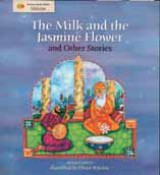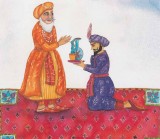Peter Greaves considers the lessons we can learn from religious stories...
Perhaps because it is the oldest teaching technique in existence, stories tap deep into the human spirit. When we hear a story, we can learn something about life, something about the storyteller and of course, something about ourselves. This makes story an integral part of RE, although care should be taken that lessons do not stray too far into the domain of literacy. Instead, they should reflect the unique flavour of religious education itself.
RE has no statutory National Curriculum orders but is a statutory part of the School Curriculum. Governing bodies of individual schools will usually choose to adopt the local Agreed Syllabus or a church syllabus. There is Non Statutory guidance however, that unifies the RE taught in the majority of schools. This unity can be found in the two strands that commonly run through the subject; the first being ‘Learning about Religions’ and the second ‘Learning from Religion’.
Making sure both these strands are covered is what makes the use of story in RE different. We are not looking to merely infer and deduct, but to learn about the beliefs and believers for whom a particular story is special. As we do that, we are also encouraging pupils to consider what is special to them.
Here are five activities based around the story of Duni Chand, a tale from the Sikh tradition. These activities could be adapted for pupils throughout KS1 and KS2. They all have elements of ‘Learning about Religions’ and ‘Learning from Religion’ and could be modified to address any story that you may be using in RE at the moment.
 The story tells how Guru Nanak, the founder of the Sikh religion, meets a very wealthy man named Duni Chand, whose only desire is to become the richest person in the city. Guru Nanak gives Duni Chand a silver needle and asks him to return it to him in the next world. Duni is honoured by the request, but when he shows the needle to his wife she laughs at him. He cannot carry the needle to the next world, she explains, and neither can he take his gold and riches. Thus enlightened, Duni Chand returns to Guru Nanak and pledges to use his money to help the poor.
The story tells how Guru Nanak, the founder of the Sikh religion, meets a very wealthy man named Duni Chand, whose only desire is to become the richest person in the city. Guru Nanak gives Duni Chand a silver needle and asks him to return it to him in the next world. Duni is honoured by the request, but when he shows the needle to his wife she laughs at him. He cannot carry the needle to the next world, she explains, and neither can he take his gold and riches. Thus enlightened, Duni Chand returns to Guru Nanak and pledges to use his money to help the poor.
A suitable version of the story can be downloaded from the Cumbria and Lancashire Education Online website http://tiny.cc/jobqL
An illustrated version of Duni Chand’s encounter with Guru Nanak is available from QED Publishing within a collection of stories called The Milk and the Jasmine Flower. http://www.qed-publishing.com (ISBN 978-1-84835-010-6).
 Chart the emotional journey…
Chart the emotional journey…
This activity focuses on the changing emotions of the central character in the story. Pupils are given a series of statements from throughout the story, which they have to organise chronologically along the x-axis of a graph and in terms of emotion on the y-axis. Younger pupils can do this in terms of a ‘happy-sad’ continuum; whilst older pupils can be asked to give a name to the emotion they feel Duni Chand would be experiencing at a given point, annotating the y-axis accordingly. The value of this activity is found in the discussion over where to place a particular statement, so it needs to be completed in pairs or small groups.
When the graphs are completed, pupils should have the chance to look at the ideas of others, as some statements can illicit very different responses in terms of identified emotion. Choose such a statement for the plenary, focusing on what a Sikh believer might say about this point in the story and how it might help them to know what to do in their own life.
Encourage self reflection…
Take a box of chocolates and use it as a stimulus to discuss the nature of ‘generosity’. Lead into the question of what a person can be generous with. Show younger pupils and help older pupils arrive at ideas such as ‘time’, ‘possessions’ and ‘talents’. Ask pupils to identify those in their lives who are generous with these things and put this into words or pictures – “My Dad is generous with his time because he gives up every Saturday morning to take me to sports club.”
Use these discussions and responses to establish a class ‘Generosity Bank’ where pupils pledge to be generous with their time, possessions or talents – “I’ll be generous with my colouring pencil set.” “I’ll be generous with my drawing talent if anyone needs help.”
How does Duni Chand alter his outlook?
A central outcome of the story is the change that comes about in Duni Chand after his encounter with Guru Nanak. Challenge pupils to produce a ‘before’ and ‘after’ portrait of Duni Chand in words, pictures or both. Pupils should select appropriate adjectives, verbs and adverbs to describe the personality and actions of the character. Older or more-able pupils can develop this by considering the consequences, or writing speech bubbles, for those who were impacted by his behaviour. This activity can be done in pairs, small groups or by individual pupils with differentiation coming through expectation of the sophistication of a pupil’s response.
 Who would the children like to question?
Who would the children like to question?
Meeting someone wise and well known challenged Duni Chand to think about the way he was living his life and this story challenges Sikh believers to do the same. Talk with the class about who pupils consider to be wise and well known. Be sure not to dismiss their suggestions, rather use them to explore their understanding of ‘wise’. Develop this into an activity where they respond to questions such as, “If I was to meet N, I would ask him…” and “I think N would look at my life and tell me to…”
 What’s the crux of the story?
What’s the crux of the story?
In every story of transformation there is always a key moment where the path of the central character changes, sometimes without them knowing it has happened. The children may have many different ideas as to when this moment occurs. Some pupils may think it was the moment the invitation was given, others may say it was when the needle was given and others still may say it was the moment Guru Nanak challenged Duni Chand about his wealth.
Ask children to imagine that this story was a video. In a time of quiet, ask them to play it through in their minds and press the pause button when they reach the most important moment in the story. They can then be asked to show the freeze frame in their mind through art, drama, digital photos, plasticine or any other medium that may be available in the classroom. Ask pupils to annotate their response by completing the sentence, “I think this is the most important moment in the story because…”
If you’d like to discover more exciting ways to teach RE, then why not book a training day with religious education consultant Gill Vaisey? Find out more at booksatpress.co.uk or call 01594 516490.
Why every child should feel at home in an art gallery
Ace-Art-And-Design
Use coaching to turn failures into learning success
Ace-Classroom-Support
Why Boarding School Fiction Feels Comfortably Familiar
Ace-Classroom-Support
